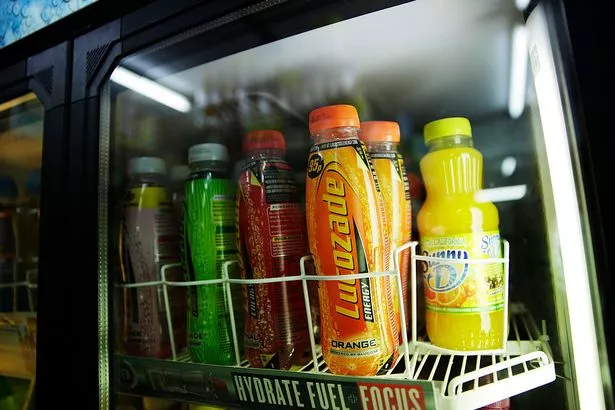The ‘innovative’ use of a carbonated beverage for diagnosis during echocardiography Bottles of Lucozade energy drink, produced by GlaxoSmithKline Plc, sit displayed for sale inside a supermarket in Godalming, U.K., on Thursday, May 2, 2013. U.K. consumer confidence unexpectedly declined in April as inflation extended its run above the Bank of England’s goal, increasing households’ concern about their personal finances. Photographer: Chris Ratcliffe/Bloomberg via Getty Images
Bottles of Lucozade energy drink, produced by GlaxoSmithKline Plc, sit displayed for sale inside a supermarket in Godalming, U.K., on Thursday, May 2, 2013. U.K. consumer confidence unexpectedly declined in April as inflation extended its run above the Bank of England’s goal, increasing households’ concern about their personal finances. Photographer: Chris Ratcliffe/Bloomberg via Getty Images
Lucozade has been praised as an affordable and effective diagnostic aid for medics after an inventive team of heart specialists in Limerick utilised the well-known drink whilst treating a woman experiencing chest pain and palpitations.
The 25 year old patient had an initial ultrasound scan, which identified a growth situated just behind her heart. There were concerns that this could potentially be an aortic aneurysm or a tumour.
However, rather than subjecting the woman to the expense, waiting time and worry of arranging more detailed cross-sectional imaging, specialists at Eagle Lodge Cardiology Clinic in Limerick opted for a bottle of Lucozade instead.
She consumed 200ml of the carbonated soft drink before doctors carried out the ultrasound scan again. This time, “swirling bubbles” consistent with gas movement were visible within the growth that had been identified.
This demonstrated that the mass behind her heart was in fact part of her stomach, rather than a life-threatening aortic aneurysm or potentially cancerous tumour. A sliding hiatus hernia was diagnosed, reports the Irish Mirror.
The consumption of Lucozade also enabled the cardiac team to observe that the mass was moving with the patient’s breathing and peristalsis – the muscular motion that propels food through the digestive system.
This confirmed that the growth was a herniated portion of her stomach, which had slipped into her chest cavity through the diaphragm. A case report from the team at Eagle Lodge, featured in the latest edition of the Irish Journal of Medical Science, praised the “innovative” application of a fizzy drink for diagnostic purposes during echocardiography.
 Bottles of Lucozade and Ribena juice, produced by GlaxoSmithKline Plc, sit displayed for sale inside a cooler at a store in London, U.K., on Sunday, Sept. 8, 2013. Suntory Beverage & Food Ltd. agreed to buy the Lucozade and Ribena drink brands from GlaxoSmithKline Plc for about 1.35 billion pounds ($2.1 billion) as the Japanese company reduces reliance on its domestic market. Photographer: Matthew Lloyd/Bloomberg via Getty Images
Bottles of Lucozade and Ribena juice, produced by GlaxoSmithKline Plc, sit displayed for sale inside a cooler at a store in London, U.K., on Sunday, Sept. 8, 2013. Suntory Beverage & Food Ltd. agreed to buy the Lucozade and Ribena drink brands from GlaxoSmithKline Plc for about 1.35 billion pounds ($2.1 billion) as the Japanese company reduces reliance on its domestic market. Photographer: Matthew Lloyd/Bloomberg via Getty Images
The medics observed that digestive system structures such as hiatus hernia can occasionally “mimic” heart conditions, and in this instance the differential diagnosis included an aneurysm, tumour, or oesophageal duplication cyst.
“This simple bedside intervention enabled real-time clarification of the finding, obviating the need for additional imaging,” wrote the authors of the report. “This rapid, non-invasive test obviated the need for cross-sectional imaging.”
The patient was given reassurance by the cardiac team and referred for outpatient gastroenterology assessment.
The authors characterised the use of Lucozade in this instance as a “low-cost” intervention that utilised the functional element of the ultrasound scan.
“Ingestion of a carbonated beverage provides a simple, safe, and effective bedside tool for distinguishing hiatus hernias from pathological cardiac or mediastinal masses,” they wrote.
“This method may help prevent unnecessary advanced imaging and highlights the value of creative problem-solving in echocardiographic practice.”
Join our Dublin Live breaking news service on WhatsApp. Click this link to receive your daily dose of Dublin Live content.
We also treat our community members to special offers, promotions, and adverts from us and our partners. If you don’t like our community, you can check out any time you like. If you’re curious, you can read our Privacy Notice .
For all the latest news from Dublin and surrounding areas visit our homepage .

